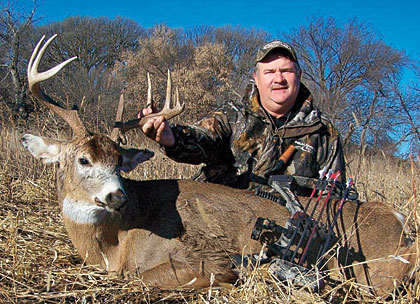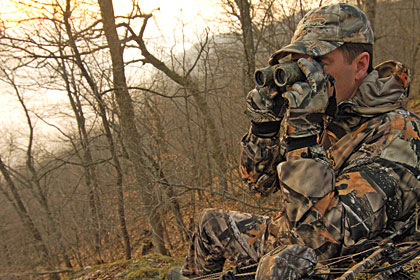January 07, 2011
By Darren Warner
Targeting Whitetails at Eye Level.
By Darren Warner
I moved slowly through the cattails bordering a marsh whitetails use as a bedroom. With a bow in one hand and a wind detector in the other, I tried to take on the persona of a jaguar silently gliding through a South American jungle. I took a few steps, stopped, eyed the landscape and then moved again -- all the while thinking, What the heck am I doing?
Like most bowhunters, I'd spent most of my time hunting from a treestand. When I wanted to learn more about the ins and outs of still-hunting, I turned to popular hunting magazines, looking for sage wisdom on the topic.
Advertisement
Problem was, I found very few stories that provided the "how-tos" of still-hunting. Most dealt with how to shoot from odd angles or how to judge shooting distances when still-hunting. They were interesting, but what good is knowing how to make a 15-yard shot in a swamp if you don't first know how to creep up on a deer?
I suspect a lot of other archers are in the same boat. Today's hunters find it hard to imagine that our ancestors didn't hunt from a hang-on or ladder stand. Treestands didn't become popular until the 1970s, meaning that for most of human history, whitetail hunters brought home the backstrap by still-hunting.
Advertisement
 Have a buddy set up targets in the woods and then practice still-hunting by slowly moving through the area and working on how quickly you can acquire each target and make a clean, ethical shot.
|
Fortunately, there are still old-timers around who have mastered this art. So, pull up a stool and prepare to learn what you need to know to take on the challenge of still-hunting and walk away victorious. We'll cover when to still hunt, what equipment to bring, how to practice the craft and advanced still-hunting strategies.
When to Still-Hunt
Weather conditions play a huge role in determining whether the day is conducive to still-hunting. Look for cloudy, wet and/or windy days, as these conditions will prevent a deer from seeing your shadow and hearing your footfalls.
"Fog is another good time," suggested Brad Harris, legendary bowhunter and manager of Southern Cross Ranch. "I believe that bucks have a false sense of security in fog -- they feel like they're invisible."
Harris also prefers to still-hunt early in the morning or late in afternoon, when deer tend to be on the move. For Harris, it is a numbers game. He believes that the more deer are moving, the better his odds are of catching a buck with its guard down.
Habitat also plays a role in deciding if still-hunting is the right choice. Look for areas with heavy cover and a thick understory. That will break up your outline, making it difficult for deer to spot you. There's a fine line between good cover and stuff that's just too overgrown and nasty to get through.
| Still-Hunting Checklist | 

Use this checklist to help decide if conditions are right for still-hunting. If you can place a check in most boxes, then go for it! – Raining
– Windy
– Cloudy
– Proper Wind Direction
– Sufficient Cover
– Mild to Moderate Local Hunting Pressure
– Won't Run Into Other Hunters
|
|
"You've got to be able to see a little, and it can't be too thick, where you can't get through without making a lot of noise," Harris said.
Something else to consider is how the deer are behaving in your area. Are deer on high alert because they've been hunted heavily? If so, you're better off settling into a treestand. Early in the season, before deer have felt hunting pressure, or during a late season, when deer have calmed down, are good times to still-hunt.
Successful still-hunting also requires the right equipment and clothing. Start with a pair of lightweight, waterproof boots with soles designed to shed dirt and mud. Hunting boots made for long sits are a poor choice, because they're heavy and hold mud.
Choose quiet clothing that resists briars and burrs. You'll be walking a fair amount, so leave the bulky hunting suit at home.
 Legendary deer caller and hunter Brad Harris has taken many bucks by still-hunting. |
Use a bow designed with forgiveness in mind. It's easy to get caught up in the need for speed, but you want a bow that will shoot accurately under the widest range of conditions.
Select a moderately weighted arrow (7-9 grains per pound of draw force) to achieve quiet flight and good penetration. A lighter arrow will shoot faster, but it also will be noisier.
A good pair of binoculars is a must when still-hunting. Select a pair that is light and provides a wide field of view.
Also carry a compass or GPS unit to keep you on track and a wind detector to keep the wind in your face.
Practice the Art
We all have heard stories about some guy who got bored sitting in his treestand and decided to get down and still-hunt back to camp. Seemingly out of nowhere, a gigantic buck appeared, carefully maneuvering its wide rack through overhanging brush. As the buck looked away, the arrow took flight, leaving the hunter to enjoy the spoils of his skill.
It's a great story. Unfortunately, it's probably either completely made up or a once-in-a-lifetime experience for some lucky
SOB who just happened to be in the right place at the right time.
 Always carry a good pair of binoculars that offer a wide field of view. Some optics manufacturers even offer binoculars with built-in image stabilization for faster target acquisition. |
The truth of the matter is that still-hunting is hard work -- not for the faint of heart or the impatient.
"It takes a lot of awareness, and you must be able to stay alert for long periods of time," said legendary traditional bowhunter Gene Wensel, author of Buckskin and Bone. "A still-hunter is someone with the hunting style of a cat, like a mountain lion, who can creep along and sneak up on game."
Just as it takes a lot of practice to become proficient with a bow, it takes practice to become an adept still-hunter. A friend of mine practices by visiting a deer ranch and walking through the terrain, keeping track of the number of times he spots a whitetail before it spots him.
You can do the same thing by going to an area where deer hang out and simulating real hunting conditions. Be sure to wear your hunting clothing and carry all your equipment. Try sneaking up on an old matriarch doe and mimic coming to full draw before she busts you. If you can do that, successful still-hunting isn't far away.
| Common Still-Hunting Mistakes | 

Avoid these blunders, which can cost you a shot at the buck of a lifetime: €¢ Moving too quickly. You know you're guilty if you don't see any deer or if squirrels are barking at you.
€¢ Not paying enough attention to wind direction. Always know the direction the wind is blowing and how terrain features influence it.
€¢ Taking a poor shot angle or selection. "If you think you may be able to get an arrow through something, you probably shouldn't be shooting," advises veteran still-hunter Gene Wensel.
€¢ Dressing too warm. Other than spooking deer, nothing's worse than getting overheated while still-hunting.
€¢ Being unbalanced. To make walking and shooting easier, equally distribute the weight of your hunting equipment around your body.
€¢ Forgetting water. Still-hunting is hard work. If you're dying for a drink of crisp, clean water, you won't be concentrating on finding deer.
€¢ Allowing boredom to creep in. Still-hunting is all about staying alert for long periods of time.
|
|
Advanced Strategies
Before still-hunting, plan the distance you want to cover and the direction you'll be traveling (always keeping the wind in your face) and know the location of every obstacle, like a ridgetop or field, that will make it difficult to traverse the area without getting busted. Get your hands on an aerial photo of the landscape and mark it up with this key information. This is a great way to make certain you haven't overlooked something that could come back and bite you when hunting.
There's been a lot written about what to look for when still-hunting. Most recommend keeping your eyes peeled for a small tuft of white hair or the glint of an antler. Focusing on these small visual cues may lead to success for some, but it also can cause a hunter to miss the forest for the trees.
"I'm looking for movement and anything out of place," said Harris. "That way, I don't miss a doe watching me while I'm sneaking up on a buck."
Nothing sounds more out of place in the woods than human footsteps. So, move slowly and try to mimic a whitetail walking. Don't allow your legs to move at a faster pace than your eyes can see. Remember that success isn't judged by distance traveled.
When a deer busts you (noticed I didn't say if), remain perfectly still. If the deer doesn't run off, try imitating the sounds of a squirrel chattering, something deer are used to hearing. Then consider what you may have done to alert the deer. Although there are some common still-hunting mistakes (see sidebar), don't beat yourself up. Even the best get busted.
"One time I spotted a nice, 150-class buck coming down a ridge toward me," recalled Harris. "I got in position behind a big tree to intercept him. I don't think he saw or smelled me -- he just seemed to sense me. He turned 180 degrees and went back the way he came."
When still-hunting agricultural areas, walk down the rows (not across) and pay special attention to the wind. "Corn can act as a baffle and make the wind bounce around," Wensel said.
Wensel also recommends knowing how deer are using the field. For example, deer that are in a cornfield to feed will likely be found in the first 15 rows, while those using corn for security are more likely to be found in the middle of the field. If you're not sure, ask the farmer who planted the field where the deer congregate.
When hunting woods or heavy thickets, pay attention to how the shape of the trees affects wind direction. Boughs angled upward will lift the wind, while those facing downward will push the wind down.
Also know how the wind moves through the area you're hunting during different parts of the season. Wind moves through hardwoods one way early in the season when the leaves are still on the trees and another way after all the leaves have fallen.
Use these strategies and you might just find yourself starring in a true story about the bowhunter who mastered the art of still-hunting and the buck that was his reward!
